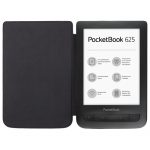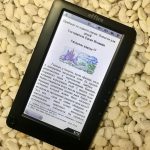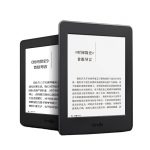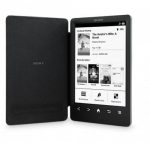 Among the wide range of e-books presented on the modern market of devices, the most high-quality copies are models with a screen made on the basis of the latest E-Ink technologies (electronic ink). What are digital gadgets with ink displays? What is their advantage over other "readable" devices? Is it worth paying attention to the type of screen when buying an e-book? Today we will clarify these issues once and for all.
Among the wide range of e-books presented on the modern market of devices, the most high-quality copies are models with a screen made on the basis of the latest E-Ink technologies (electronic ink). What are digital gadgets with ink displays? What is their advantage over other "readable" devices? Is it worth paying attention to the type of screen when buying an e-book? Today we will clarify these issues once and for all.
Content
Technology description
By opting for an e-book with the claimed display made using electronic ink, the buyer expects, above all, to get a high-quality image. His expectations will be met. As a result of using this technology to create a display, the text displayed by him will look almost the same as it would look if it was written on paper. The technology has brought the digital reader so close to paper that now even when using it, the lighting required to read a regular book is needed.
Of course, no one writes on digital media with liquid “paints” to give naturalness, everything is much more interesting. The principle of creating E-Ink displays is based on the process of “embedding” microcapsules with black and white microspheres under the screen. When an electric field created inside the device acts on such a capsule, depending on the polarity, microparticles of the corresponding color rise on its surface. As a result of this process, there is a change in its color and the corresponding "reproduction" of the written code of the book, which appears to the reader in plain text.
In addition to the main one, some electronic gadgets are equipped with an additional touch layer. Thanks to him, the reader user can control the acquired device with just the touch of a finger.
For the modern segment of electronic books, E-Ink Corporation has created several types of its technology that are distinguished by the quality and perfection of the built-in functionality:
- E-Ink VizPlex (the "debut" technology of electronic ink, which today has much better "successors" in terms of display resolution);
- E-Ink Pearl (this type of screen, as well as the 2 following in the list belong to the second generation of E-Ink, characterized by improved contrast, response time to "commands" of the user, as well as power consumption);
- E-Ink Pearl HD;
- E-ink carta;
- E-Ink Flex (considered an alternative to creating electronic books "with the effect of a paper medium", having a flexible body while maintaining the full functionality of the reader);
- SiPix (is a lower-quality analogue of E-Ink, the principle of which implies the presence of white microparticles floating in a black liquid).
For the opportunity to give an objective assessment of displays with electronic ink, it is necessary to clearly articulate the main advantages and disadvantages of the technology.
Benefits:
- The absence of negative effects on eye health, even with prolonged use of the e-book reader. This advantage is due to the exclusion of the flickering backlight, familiar to displays of other gadgets, from the design of the E-Ink screen.
- A long time saving the initial battery charge of the gadget. A long battery life becomes possible due to the lack of energy-consuming factors, such as backlighting. The main power consumption in this case is to “turn over” the pages, and not to reproduce the text on the display itself.
- Reading comfort. Gadgets with E-Ink technology minimize the possibility of glare or image distortion when changing the angle during use or changing the level of illumination of the surrounding room.
Disadvantages:
- Inability to read in the dark. Due to its proximity to the paper page, the E-Ink display does not light up in the dark.This feature can create certain difficulties for users who prefer to read e-books before bedtime. However, manufacturers, trying to correct possible discomfort, attach special covers with a flashlight to their readers.
- Exposure to mechanical damage, especially VixPlex and Pearl models. This significant drawback of E-Ink e-books necessitates the creation of a case and the "frame" of the gadget from durable materials or alloys, which significantly adds weight to it.
- Slow update, eliminating the possibility for the manufacturer to embed complex animated interface elements into a digital reader.
- Cost. E-books with displays on electronic ink cost an order of magnitude more than their counterparts with LCD screens due to the complexity of the design and use of expensive materials in the manufacture of the gadget of the type described.
Based on the above characteristics, we can conclude that the E-Ink technology is imperfect. However, given its merits, it becomes obvious the advisability of choosing the user in favor of devices with a display on electronic ink compared to ordinary counterparts.
Top models
To clearly illustrate the technical characteristics of E-Ink devices, it is worth considering the functional indicators of the top model.
ONYX BOOX Chronos
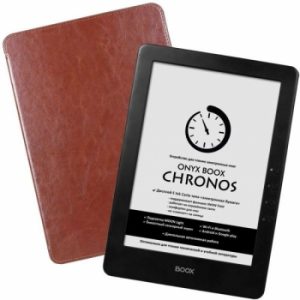
- Screen Type: E-Ink, Touch
- Ink Grade: Carta
- Display Size: 9.7 inches
- Weight: 450g
- CPU Frequency: 1000 MHz
- RAM: 512 MB
- Built-in memory: 8 GB
- Memory card slot: yes
- Supported formats: TXT, DOC, PalmDOC, PDF, fb2, ePub, DjVu, RTF, MOBI, PRC, FB3, JPEG, BMP, GIF, PNG, HTML, CHM, ZIP
- Battery Capacity: 3000 mAh
- Additional functions: Wi-Fi module, Bluetooth, page turning buttons on the case
- High-quality text playback on the device screen
- a large number of standard applications pre-installed by the manufacturer
- lack of errors in assembly
- built-in bluetooth module
- heavy weight
- fast battery consumption
- slow update interface
- sensor insensitive to user commands
PocketBook 615 Plus
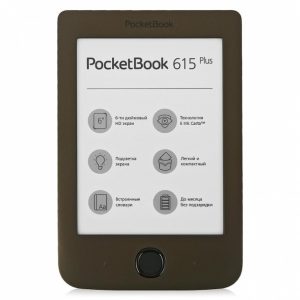
- Screen Type: E-Ink
- E-Ink View: Carta
- Display Resolution: 6 inches
- Weight characteristic: 170 g
- CPU Frequency Response: 1000 MHz
- RAM: 256 MB
- Built-in storage for downloaded files: 8 GB
- Memory card support: yes
- Valid file extensions: TXT, DOC, PDF, fb2, ePub, DjVu, RTF, PDF (DRM), EPUB (DRM), DOCX, PRC, TCR, CHM, MOBI, ACSM, JPEG, BMP, TIFF, PNG, HTML, CHM, ZIP
- Battery capacity: 1300 mAh
- Preset options: buttons for paging, built-in backlight
- presence of backlight with the possibility of its regulation
- high-quality display performance
- a large number of supported formats
- The "slowness" of the gadget
- lack of a touch layer of the display
Ritmix RBK-615
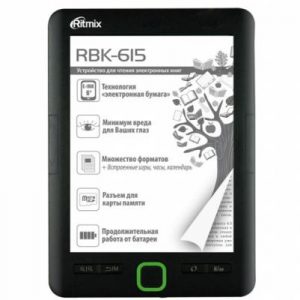
- Screen Type: E-Ink
- E-Paper Subtype: Carta
- Display Resolution: 6 inches
- Weight: 160g
- RAM: 256 MB
- The amount of internal memory: 4 GB
- Memory card slot: yes
- Valid document formats: TXT, PalmDOC, PDF, fb2, ePub, RTF, MOBI, JPEG, BMP, GIF, PNG, HTML
- Battery capacity: 1500 mAh
- Additional features from the manufacturer: pre-installed games, mechanical buttons for turning pages of an e-book
- long operation of the gadget without additional recharging
- balanced display
- thoughtful function menu
- quality assembly
- "Slow" processing of "commands" gadget
- extremely fragile display
PocketBook 614 Plus

- Display Type: E-Ink Carta, Touch
- Screen Feature: 6 inch
- Weight: 170g
- Processor Specifications: 1000 MHz
- RAM capacity: 256 Mb
- The amount of internal memory: 8 GB
- Memory card slot: yes
- Formats that can be played on the device: TXT, DOC, PDF, fb2, ePub, DjVu, RTF, MOBI, JPEG, BMP, TIFF, PNG, HTML, CHM, ZIP
- Battery capacity: 1300 mAh
- Additional options provided by the manufacturer: page turning buttons
- “Reliable” product quality
- long operating time that does not require recharging the battery
- lack of built-in screen lighting
- lack of built-in Wi-Fi module
Reader book 2
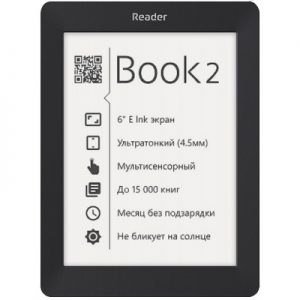
- Display Type: E-Ink Pearl, Touch
- Screen Feature: 6 inch
- Weight: 140g
- CPU: 1000 MHz
- RAM capacity: 256 Mb
- The amount of internal memory: 4 GB
- The ability to use a memory card: yes
- Available formats: TXT, DOC, PDF, fb2, ePub, DjVu, RTF, MOBI, JPEG, BMP, GIF, PNG, HTML, CHM, ZIP
- Battery: 1300 mAh
- Additional functions: paging buttons, Wi-Fi module
- “Reliable” product quality
- ergonomics and compactness
- build quality
- short battery life
Based on the above information, it becomes obvious that e-books with a display using E-Ink technology significantly exceed their counterparts, while having certain disadvantages. Should I make a choice in their favor? If you prefer a quality product that provides the opportunity for comfortable use, it is definitely worth it.
